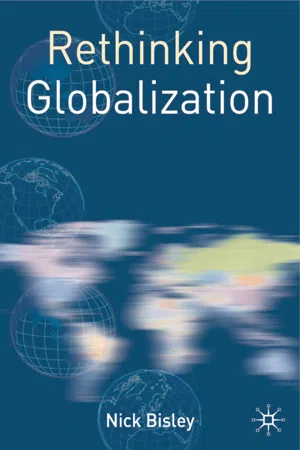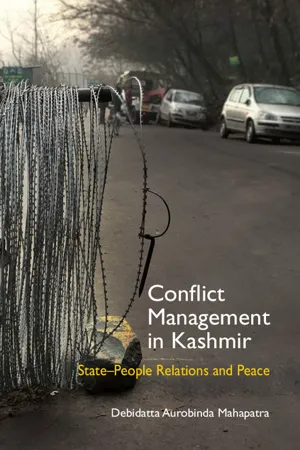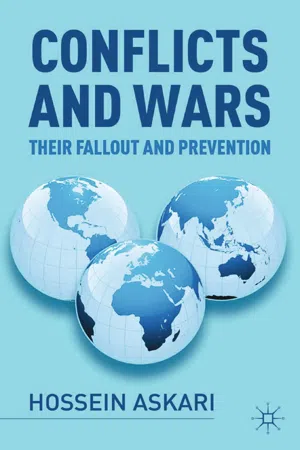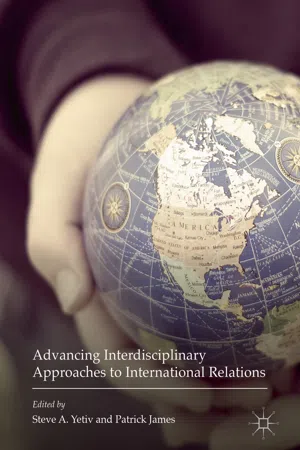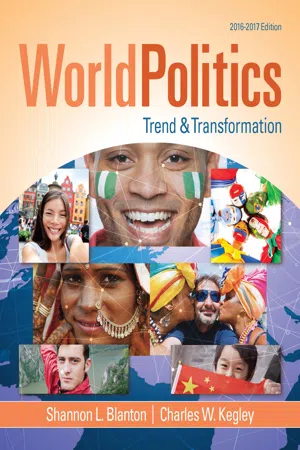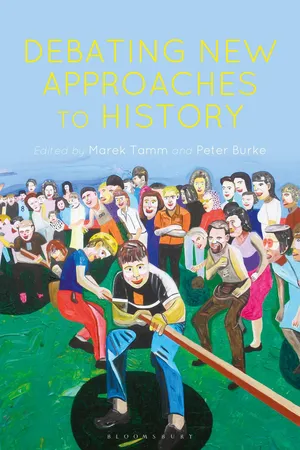History
Global Conflict
Global conflict refers to large-scale military, political, or economic disputes involving multiple countries or regions. These conflicts often have far-reaching consequences and impact the course of world history. Examples include World War I and World War II, which reshaped international relations and led to significant geopolitical changes.
Written by Perlego with AI-assistance
Related key terms
1 of 5
6 Key excerpts on "Global Conflict"
- eBook - PDF
- Nick Bisley(Author)
- 2017(Publication Date)
- Bloomsbury Academic(Publisher)
Analysis of the character of war is necessary beyond the insight that it provides into the nature of contemporary social conditions. 136 There is a pervading sense that war itself is undergoing a significant transformation, and in part this is thought to result from globaliza-tion. War is subject to globalization as well as being a force which contributes to its ongoing dynamic. Given the scale of issues related to warfare and globalization, and the space constraints of the chapter, it is necessary to focus on the core issues. To that end, the chapter will firstly consider the extent to which globalization increases the vulnerability of states and societies to threats, as well as the way in which globalization can also limit how and to what ends the organized use of force is deployed. The second section examines the conduct of war and assesses how globalization has changed the way wars are fought. The final section examines the purpose of wars and sets the growing sense that the use of force in the international system is illegitimate alongside the continuing incidence of low-intensity war and a growing interest in humanitarian, or what one leading scholar has called ‘humane’, war (Coker, 2001). War and Conflict Prior to delving into these issues it is necessary to clarify how the concept of war is being used here. From the very earliest traces of human civilization war has been central to social experience. One need only look at the centrality of war to human cultural expression and valorized symbols to grasp its ubiquity. From the defining myths of nations – Kosovo for Serbs, Gallipoli for both Turks and Australians – to the memorials and monuments to fallen warriors, such as Des Invalides in Paris or Yasukuni in Tokyo, war is a central component of our modern sense of identity. Yet while it is intuitive to speak of war in such a fashion, in the context of the study and practice of war it means something relatively specific. - eBook - PDF
Conflict Management in Kashmir
State-People Relations and Peace
- Debidatta Aurobinda Mahapatra(Author)
- 2017(Publication Date)
- Cambridge University Press(Publisher)
2 Theorizing Conflicts Conflict broadly implies pursuit of incompatible goals, which can range from competition over resources to contradictory needs and interests. While Coser (1956) defines conflict as struggle over values and claims to scarce resources, Pruitt and Rubin (1986) define it as perceived divergence of interest or a belief that parties’ current aspirations cannot be achieved simultaneously. Four criteria separate a conflict situation from other situations: first, the participants in a conflict must perceive that there is a conflict; second, there is a clear difference of values, interests, aims or relations at the root of the conflict; third, the parties to the conflict are either states or significant elements of the population within the state; and four, the outcomes of the conflict are considered important by the parties (Miall, 1992). Over the years, the patterns of conflicts have changed. The end of the Cold War witnessed decline in interstate warfare and sharp rise in conflicts confined to the borders of states. According to Wallensteen and Axell (1994), 90 armed conflicts took place in 61 locations around the world from 1989 to 1993. Out of these, only four were interstate armed conflicts and the rest were intrastate conflicts, implying that in the post-Cold War period the conflict actors were not only the states. Holsti (1996, 20) refers to internal conflicts, many of which are ethnicity based, as the wars of ‘third kind’. For him, the wars of the third kind have different profiles. In these wars: [n]o single crisis precipitates them, and they typically do not start at a particular date. There are no declarations of war, there are no seasons for campaigning, and few end with peace treaties. Decisive battles are few … wars are fought by loosely knit groups of regulars, irregulars, cells, and not infrequently by locally-based warlords under little or no central authority. The post-Cold War conflicts are complex in multiple ways. - eBook - PDF
Conflicts and Wars
Their Fallout and Prevention
- Hossein Askari(Author)
- 2012(Publication Date)
- Palgrave Macmillan(Publisher)
Consequently, a regional system emerged whereby countries became regional allies to benefit from special regional resources, unique geographical positioning, or collective protective capacity (Glaser). The emergence of new identities, built around new free countries, has promoted regionalization. Regional powers tend to regulate their interests independently, prompting or forcing other countries in the region to group around them or to ally with them. These new regional powers (countries such as India, Turkey, and Nigeria) do not compete for global hegemony, but they are of special interest to superpowers competing for supremacy. Conflicts among regional powers tend to be mostly over resources or territory. The Changing Trends and Characteristics of Conflicts and Wars According to Glaser, since the 18th Century [a period of only about two hundred years], some 471 wars were fought resulting in about 120 million war-related deaths; over 90% of these deaths occurred in the 20th Century. Of the 250 wars fought in the 20th Century, 194 occurred in the period 1945–1995, 90% of them taking place in developing countries, causing some 45 million war- related deaths; in the period 1990–1995 alone, 70 states were involved in 93 wars in which 5.5 million people died. Several important characteristics of recent conflicts stand out. First, the overwhelming majority of wars are intrastate conflicts, with classic inter- state conflicts accounting for only 15 percent of all conflicts. The share of civilian deaths has been increasing; the average percentage of civilian deaths in World War I was 50 percent, rising to 73 percent for wars in the 1970s, and was estimated at 85 percent in the 1980s. Lacina et al., using revised information on battle-related deaths from 1900 to 2002, demon- strated that the risk of death in battle declined significantly after World War II and again after the end of the cold war. - Steve A. Yetiv, Patrick James, Steve A. Yetiv, Patrick James(Authors)
- 2016(Publication Date)
- Palgrave Macmillan(Publisher)
for order carried out in both domestic and international politics.” (in May et al. 2010: 87). Regardless of whether one agrees with his argument, it certainly frames the larger question of the weight of different causes of war and does so with historical evidence. And such work, alongside the use of databases on war such as that developed by Richard Ned Lebow (2010b), could augment our understanding of the motives for war over time. History can also inform the potential change in the causes of interna- tional conflict writ large. For instance, are tensions over resources such as oil and water a more or less common cause of conflict over time? How about the role of individual leaders in an age of greater communications? How about refugee crises and environmental problems? Human security factors of this kind are emphasized in non-traditional definitions of secu- rity; in what ways have they gained in importance over time? (see Kerr 2009). Comparison over time is crucial for answering such questions, which history can help execute either through in-depth work such as case studies or by helping to identify and explore indicators of change over time. Third, IR could do far more to explore the effects of the fall of empires. That would help illuminate many concerns in IR in such failed states and the conflicts they generate; decolonization and the conflictual struggle between the strong and weak; and numerous conflicts over borders and resources, especially in the Middle East. History is integral to this exploration. Many historians have engaged the question of empire. Gibbon’s Decline and Fall of the Roman Empire comes to mind as well as the seminal and acclaimed work of Braudel (1972), who investigated the clash of empires and cultures in the Mediterranean in the sixteenth century by looking broadly at contexts (agricultural, financial, economic, demographic, technological, etc.) and back through historical development over a millennium.- No longer available |Learn more
- Shannon Blanton, Shannon Blanton, Charles Kegley(Authors)
- 2016(Publication Date)
- Cengage Learning EMEA(Publisher)
Based on even these few events, it becomes understandable why so many people think that armed conflict is the essence of world politics. In On War , Prussian strategist Karl von Clausewitz advanced his famous dictum that war is merely an extension of diplomacy by other means, albeit an extreme form. This insight underscores the realist belief that war is a policy instrument that transnational actors use to resolve their conflicts. War, however, is the deadliest instrument of conflict resolution, and its onset usually means that persuasion and negotiations have failed. In international relations, conflict regularly occurs when actors interact and disputes over incompatible interests arise. In and of itself, conflict is not necessarily threatening because war and conflict are different. Conflict may be seen as inevitable and occurs whenever two par-ties perceive differences between themselves and seek to resolve those differences to their own satisfaction. Some conflict results whenever people interact and may be generated by religious, ideological, ethnic, economic, political, or territorial issues; therefore, it should not be regarded as abnormal. Nor should we regard conflict as necessarily destructive. Conflict can promote social solidarity, creative thinking, learning, and communication—all factors critical to the resolution of disputes and the durability of cooperation. However, the costs of conflict do become threatening when the parties take up arms to settle perceived irreconcilable differences or to settle old scores. When that happens, violence occurs, and we enter the sphere of warfare. This chapter presents information and ideas so you can explore the nature of armed conflict in your world—its causes, changing characteristics, and frequency. You will be forced to confront the ethical dilemmas that these military threats create—about when it is moral or immoral to take up arms. - eBook - PDF
- Marek Tamm, Peter Burke, Marek Tamm, Peter Burke(Authors)
- 2018(Publication Date)
- Bloomsbury Academic(Publisher)
My own preference, though not supported by a broad consensus among scholars, would be to leave global history more loosely defined as a history of transformative connections and reserve the pointed requirement of integration for the history of globalisation . This should be seen as a subfield of global history concerned with the construction of institutionalized and robust networks of planetary extension that jointly, though not without contradictions, contribute to a progressive integration of societies, Global History 29 states, and cultural arenas on the globe, especially since the technological advances of the mid-nineteenth century (Conrad 2016: 92–100; for a critical position see Lang 2014). This typology helps to gain a contrastive understanding of the characteristic features of global history. Global history, as the term is used here in a fairly narrow way, is one among several types of large-scale history. It presupposes a direction in history that is vaguely described with terms such as ‘integration’, ‘convergence’, and ‘homogenization’, moving in a dialectical rather than a continuous and steady way. Additional a priori assumptions about the overall shape of history are not required. Whereas universal history – and, even more so, Big History – has long time spans in view, world history is a history of human societies since the earliest palaeontological and archaeological evidence, and transnational history limits itself to the last 200 to 250 years, global history does not have to be long-term history. The temporalities used by global historians do not derive from a given epistemological programme but are freely chosen according to specific purposes of investigation. Few global historians are likely to go further back than c. 1500, although exciting new work has been done on the global significance of that caesura (Gruzinski 2004; Boucheron 2009). However, very few research-based studies cover several centuries.
Index pages curate the most relevant extracts from our library of academic textbooks. They’ve been created using an in-house natural language model (NLM), each adding context and meaning to key research topics.
